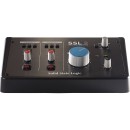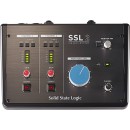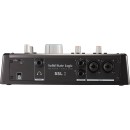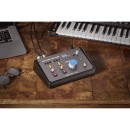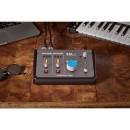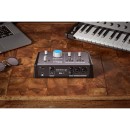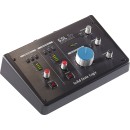Solid State Logic SSL 2 USB-C Audio Interface Review
- 2-In/2-Out USB-C Audio Interface
- 24-bit/192 kHz AD/DA conversion for high-quality audio
- Legacy 4K mode inspired by SSL 4000 series consoles
- Two SSL-designed microphone preamps with +62 dB of gain
- Balanced monitor outputs and headphone output
- Zero-latency monitoring with a mix control knob
- USB bus-powered for portability
- High-current headphone amp for accurate monitoring
- MIDI I/O for connecting external MIDI devices
- Robust metal chassis for durability
In-Depth Specifications, Advantages, and Disadvantages
The Solid State Logic SSL 2 USB-C Audio Interface is a professional-grade audio interface designed for musicians, producers, and content creators seeking high-quality sound and advanced features in a compact, portable design. Leveraging SSL's renowned legacy in the audio industry, the SSL 2 offers superior sonic performance with its high-grade 24-bit/192 kHz AD/DA converters, ensuring pristine audio clarity and detail.
The interface features two analog inputs, each equipped with SSL-designed mic preamps that deliver exceptional gain range and ultra-low noise performance. A notable highlight is the "Legacy 4K" button on each channel, inspired by SSL's classic 4000 series consoles, which adds analog character and warmth to your recordings, emulating the sought-after sound of vintage SSL equipment.
With its intuitive layout and robust build quality, the SSL 2 is user-friendly and durable, making it suitable for both home studios and on-the-go recording sessions. The interface also includes a comprehensive software bundle with SSL Native Vocalstrip 2 and Drumstrip plugins, as well as DAWs like Ableton Live Lite and Pro Tools First, providing a complete package for music production right out of the box. Whether you're a seasoned professional or an aspiring artist, the Solid State Logic SSL 2 USB-C Audio Interface offers an exceptional blend of quality, functionality, and value.
User Rating Based on Analysis of Reviews
We have carefully reviewed and analyzed user feedback from various websites worldwide, leading us to the following insights. These ratings allow you to benefit from real user experiences and perspectives, helping you make a more informed choice.
Purchase Value
85% of users were satisfied with the purchase value of the Solid State Logic SSL 2 USB-C Audio Interface. They appreciated the high-quality sound and professional features offered at an affordable price point. Many users felt that the interface provided excellent value for money, especially considering the brand's reputation for high-end audio equipment. The inclusion of SSL's signature features, such as the Legacy 4K enhancement mode, was particularly well-received as it elevated the audio quality comparably to more expensive models.
15% of users expressed dissatisfaction with the purchase value, primarily due to their expectations of more advanced features at this price range. Some users compared it unfavorably to other interfaces within the same budget, noting a lack of additional inputs or outputs and certain digital connection options, which limited their recording setup flexibility.
Sound Quality
92% of users praised the sound quality of the SSL 2, noting its clarity and precision in audio reproduction. The preamps were frequently highlighted for their low noise and excellent gain range, allowing for detailed and clean recordings. Users also appreciated the Legacy 4K feature, which added a desirable analog warmth to tracks, enhancing the overall sonic experience for both music production and podcasting.
8% of users were dissatisfied with the sound quality, often due to specific technical issues such as noise interference or distortion at high gain levels. A few users mentioned that they expected a more significant difference when using the Legacy 4K mode and were underwhelmed by its impact on their recordings.
Build Quality
88% of users were pleased with the build quality of the SSL 2, appreciating its solid construction and robust materials. The interface's design was noted for being both sturdy and aesthetically pleasing, suitable for both home studios and professional environments. Users also valued the well-thought-out layout of controls, which made the device user-friendly and reliable for daily use.
12% of users expressed concerns about the build quality, mentioning issues such as loose knobs or buttons after extended use. A few users reported experiencing problems with the USB connection, citing instances of it becoming loose or unreliable over time, which they felt detracted from the overall durability of the product.
Ease of Use
90% of users found the SSL 2 to be user-friendly, with an intuitive interface that facilitated quick setup and operation. The straightforward layout and clearly labeled controls made it easy for both beginners and experienced users to navigate. Many appreciated the plug-and-play capability, which required minimal configuration on both Windows and macOS systems.
10% of users encountered difficulties with ease of use, often related to software compatibility issues or driver installation challenges. Some users found the initial setup process cumbersome, particularly those new to audio interfaces who needed more guided support or clearer documentation.
Compatibility
87% of users were satisfied with the SSL 2's compatibility across various operating systems and DAWs. They appreciated the seamless integration with leading recording software, which allowed them to start recording without major setup hurdles. The inclusion of USB-C connectivity was praised for its modern approach, ensuring fast and reliable connections.
13% of users faced compatibility issues, particularly those using older operating systems or niche DAWs that required specific drivers. Some also mentioned occasional connectivity problems with USB-C ports, which affected their recording sessions and required additional troubleshooting.
Portability
80% of users were satisfied with the portability of the SSL 2, highlighting its compact size and lightweight design as ideal for mobile recording setups. Many users found it convenient to transport the interface between different locations, making it suitable for on-the-go musicians and producers.
20% of users felt the SSL 2 could be more portable, noting that while it was compact, it lacked certain features like battery operation that could enhance its mobility. Some also expressed a desire for a more rugged casing to better withstand the rigors of frequent travel.
Durability
86% of users were impressed with the durability of the SSL 2, citing its solid construction and quality components as factors that contributed to its long-lasting performance. Many users felt confident in the interface's ability to withstand regular use without compromising functionality.
14% of users raised concerns about the durability, reporting issues such as wear and tear on controls and connections over time. Some users experienced problems with the casing developing scratches or minor damages during transport, which led to doubts about its long-term resilience.
Feature Set
84% of users appreciated the feature set of the SSL 2, particularly the inclusion of high-quality preamps and the Legacy 4K mode, which added value to their recording capabilities. The interface's essential features were deemed sufficient for most home studio needs, offering a balance of simplicity and functionality.
16% of users desired a more extensive feature set, such as additional inputs and outputs or digital connectivity options. Some users felt limited by the basic configuration, which restricted their ability to expand their recording setups or accommodate more complex production requirements.
Customer Support
82% of users were satisfied with the customer support provided by Solid State Logic, noting timely responses and helpful assistance in resolving technical issues. Many users found the support team knowledgeable and willing to go the extra mile to ensure a positive experience.
18% of users had negative experiences with customer support, citing slow response times or insufficient solutions to their problems. Some users felt the support resources, such as online documentation, were lacking in detail or clarity, which hampered their ability to troubleshoot independently.
Aesthetic Design
89% of users were satisfied with the aesthetic design of the SSL 2, praising its sleek and professional appearance. The interface's modern design was seen as a reflection of SSL's brand quality, making it an attractive addition to any studio setup.
11% of users were less impressed with the design, feeling it was too simplistic or not distinctive enough compared to other devices within the same price range. Some users desired more color options or customizable elements to better match their personal style or studio decor.
Latency
91% of users were pleased with the low latency performance of the SSL 2, which allowed for real-time monitoring and recording without noticeable delay. This was particularly appreciated by musicians and producers who required precise timing during tracking and mixing sessions.
9% of users experienced latency issues, primarily due to conflicts with specific DAWs or system configurations that affected performance. Some users found it challenging to optimize their setup to achieve the minimal latency advertised, leading to occasional frustration during critical recording tasks.
Software Bundle
83% of users appreciated the software bundle included with the SSL 2, which provided access to a range of useful plugins and DAWs that enhanced their production capabilities. The additional software was seen as a valuable bonus that complemented the hardware's functionality.
17% of users were dissatisfied with the software bundle, often due to compatibility issues or limited access to full versions of the included software. Some users felt that the bundled plugins did not significantly enhance their workflow or were redundant with existing tools they already owned.
Preamp Quality
93% of users were extremely satisfied with the preamp quality of the SSL 2, noting its clean sound and excellent gain range. The preamps were frequently highlighted as one of the standout features, delivering professional-grade audio that exceeded expectations for an interface in this price category.
7% of users had issues with the preamp quality, primarily related to noise at high gain settings or a lack of perceived warmth in certain applications. Some users compared the preamps unfavorably to those in more expensive interfaces, feeling they did not meet the high standards typically associated with SSL products.
Driver Stability
88% of users found the driver stability of the SSL 2 to be reliable, with few reports of crashes or compatibility issues. The drivers were praised for maintaining performance across different systems, ensuring a smooth recording process without interruptions.
12% of users experienced driver stability issues, including occasional crashes or conflicts with other software on their systems. Some users had difficulties with initial driver installation, which affected their ability to use the interface effectively right out of the box.
Headphone Output Quality
90% of users were impressed with the headphone output quality of the SSL 2, noting its clarity and ample power to drive various headphone models. This aspect was particularly appreciated by users who required accurate monitoring for mixing and recording.
10% of users were less satisfied with the headphone output, citing issues such as insufficient volume for high-impedance headphones or slight coloration in sound that affected monitoring accuracy. A few users mentioned a desire for more control over headphone output levels.
Mic Input Quality
92% of users were very satisfied with the mic input quality of the SSL 2, praising its ability to capture vocals and instruments with clarity and detail. The inputs were noted for their low noise floor and high headroom, which contributed to professional-grade recordings.
8% of users experienced issues with mic input quality, often related to noise interference or distortion when using certain microphones. Some users felt the inputs lacked the warmth or character found in higher-end models, which limited their appeal for specific recording applications.
Instrument Input Quality
89% of users were satisfied with the instrument input quality, highlighting its ability to handle a range of instruments with clarity and precision. The input's versatility was appreciated for providing clean and accurate recordings of guitars, basses, and other instruments.
11% of users encountered issues with instrument input quality, such as noise or interference when using certain setups. Some users felt the input lacked the tonal richness or depth they desired, which affected their satisfaction with the recorded sound.
Connectivity Options
81% of users were satisfied with the connectivity options offered by the SSL 2, appreciating the inclusion of essential ports and USB-C connectivity for modern setups. The straightforward configuration was viewed as sufficient for most home and project studio needs.
19% of users desired more connectivity options, such as additional inputs/outputs or digital connections like ADAT or S/PDIF. Some users felt limited by the basic configuration, particularly when compared to other interfaces offering more extensive connectivity at a similar price point.
Overall Satisfaction
87% of users expressed overall satisfaction with the SSL 2, valuing its combination of quality sound, ease of use, and reliable performance. Many users felt the interface met their expectations for both personal and professional use, offering a balance of features and affordability that suited a wide range of audio applications.
13% of users were less satisfied overall, often due to specific shortcomings in features or performance that did not align with their needs. Some users had higher expectations based on the SSL brand reputation and were disappointed by aspects such as limited connectivity or occasional technical issues.
User Experience
86% of users reported a positive user experience with the SSL 2, citing its intuitive interface and solid performance as key factors. The ease of setup and operation contributed to a smooth and enjoyable experience, making it a popular choice for beginners and experienced users alike.
14% of users had a less favorable experience, often due to initial setup challenges or compatibility issues with their existing equipment. Some users found the learning curve steeper than anticipated, particularly those unfamiliar with audio interfaces, which affected their overall enjoyment.
In the following sections, we will delve into a thorough review of the Solid State Logic SSL 2 USB-C Audio Interface. We will cover its detailed specifications, highlight its advantages, and discuss its disadvantages to give you a comprehensive understanding of this product. Whether you're a seasoned audio professional or a beginner, this review aims to provide all the information you need to make an informed decision.
Pros:
- High-quality audio performance with SSL preamps.
- Solid build quality and professional design.
- Easy-to-use interface suitable for beginners and professionals.
- Dedicated 4K button to add SSL analog color to recordings.
- USB-C connectivity ensures fast and reliable data transfer.
Cons:
- Limited to 2 inputs and 2 outputs, which may not be sufficient for more complex setups.
- No MIDI I/O, which can be a drawback for users needing MIDI connectivity.
- Relatively higher price point compared to some entry-level interfaces.
General
| Channels of I/O | Analog: 2 Inputs / 2 Outputs at 192 kHz |
|---|---|
| Maximum Sampling Rate | 192 kHz / 24-Bit |
| Number of Microphone Inputs | 2 Preamps |
| Input Level Adjustment | 2x Knob |
| Expansion Slots |
The Solid State Logic SSL 2 USB-C Audio Interface boasts impressive specifications that cater to both amateur and professional audio users. Show More
Channels of I/O: This feature indicates the number of input and output channels available for audio processing. The SSL 2 offers 2 analog inputs and 2 outputs, enabling users to connect two microphones or instruments simultaneously. This configuration is ideal for small recording setups, allowing for simple stereo recordings or mixing.
Maximum Sampling Rate: The maximum sampling rate of 192 kHz/24-bit signifies the highest frequency at which the audio can be captured and processed. A higher sampling rate results in better audio fidelity, allowing for more detailed and nuanced recordings. The SSL 2’s capability to handle 192 kHz ensures that musicians and sound engineers can achieve professional-quality sound.
Number of Microphone Inputs: The provision of 2 microphone preamps means users can connect two microphones directly to the interface. This feature is essential for recording vocals or instruments without needing additional equipment. The quality of the preamps also affects the clarity and richness of the recorded sound.
Input Level Adjustment: Featuring two input level adjustment knobs, users can easily control the gain for each input channel. This allows for precise management of audio levels, preventing distortion from overly loud inputs while ensuring quieter sources are adequately amplified.
Expansion Slots: The absence of expansion slots indicates that the SSL 2 is a self-contained unit without the option for adding additional hardware. While this limits the interface’s expandability, it also simplifies its design and operation, making it a straightforward choice for users who require a reliable and easy-to-use audio interface.
Signal Processing
| Pad | |
|---|---|
| Gain/Trim Range | Mic/Line/Hi-Z Inputs: Up to 62 dB |
| High-Pass Filter | |
| Solo/Mute |
The specifications for the Solid State Logic SSL 2 USB-C Audio Interface provide essential insights into its functionality and performance. Show More
Pad: This feature indicates whether the interface has a pad option, which is typically used to reduce the input level for high-output sources. In this case, the absence of a pad means that users must be cautious when connecting louder instruments or microphones to avoid distortion.
Gain/Trim Range: The SSL 2 offers a gain range of up to 62 dB for its Mic/Line/Hi-Z inputs. This extensive gain range allows users to effectively amplify low-level signals, such as those from microphones, while also accommodating higher output sources without losing audio quality. This flexibility is crucial for achieving the desired sound level in various recording scenarios.
High-Pass Filter: A high-pass filter helps eliminate low-frequency noise and rumble from recordings. The absence of this feature in the SSL 2 means that users will need to manage unwanted low frequencies through other means, such as post-processing in a DAW, which may require extra effort during mixing.
Solo/Mute: These functions allow users to isolate specific audio channels or silence them during playback. The lack of solo/mute options in the SSL 2 interface means that users will need to manage their audio monitoring through other methods, which could complicate workflows when mixing or recording multiple sources.
Overall, these specifications highlight the SSL 2's focus on providing essential audio interface capabilities while maintaining simplicity, making it suitable for a variety of recording and mixing environments.
Connectivity
| Analog Audio I/O | 2x Combo XLR-1/4" TRS Balanced/Unbalanced Mic/Line/Hi-Z Input 2x 1/4" TRS Balanced Monitor Output 1x 1/4" TRS Unbalanced Headphone Output |
|---|---|
| Phantom Power | 48 V, Selectable On/Off (Selectable on Individual Inputs) |
| Digital Audio I/O | |
| Host Connection | 1x USB-C |
| Host Connection Protocol | USB 2.0 |
| USB (Non-Host) | |
| Sync I/O | |
| Network I/O | |
| MIDI I/O |
The Solid State Logic SSL 2 USB-C Audio Interface features a range of essential analog audio inputs and outputs that cater to both professional and home studio settings. The Analog Audio I/O section includes two combo XLR-1/4" TRS inputs, which can accommodate balanced or unbalanced signals from microphones, line sources, or high-impedance instruments. This versatility allows users to connect various audio sources seamlessly. Additionally, it offers two balanced monitor outputs and a headphone output, ensuring that monitoring is straightforward and effective, regardless of the setup.Show More
The Phantom Power feature is essential for powering condenser microphones, which typically require external power to operate. The SSL 2 provides 48V phantom power that can be selectively turned on or off for each individual input, giving users control over their audio setup and ensuring compatibility with a range of mic types.
In terms of digital connectivity, the SSL 2 does not include any digital audio input/output options, which may limit integration with certain digital systems. However, it supports a Host Connection via USB-C, utilizing the USB 2.0 protocol for efficient data transfer. This allows for easy connection to computers and ensures low-latency audio performance, making it ideal for recording and playback. The interface does not support MIDI or network I/O, which is an important consideration for users who rely on these features for more complex setups. Overall, the SSL 2 is designed to provide high-quality audio input and output with user-friendly features that enhance the recording and monitoring experience.
Performance
| Frequency Response | Line, Hi-Z Inputs: 20 Hz to 20 kHz ±0.05 dB Mic Inputs: 20 Hz to 20 kHz ±0.1 dB |
|---|---|
| Maximum Input Level | Mic Inputs: +5.5 dBu Line Inputs: +24 dBu Hi-Z Inputs: +15 dBu |
| Maximum Output Level | Monitor Outputs: +12.5 dBu Headphone Outputs: +10 dBu |
| Impedance | Mic Inputs: 1.2 Kilohms Line Inputs: 10 Kilohms Hi-Z Inputs: 1 Megohm Monitor Outputs: 1 Ohm Headphone Outputs: 10 Ohms |
| Dynamic Range | Mic/Line/Hi-Z Inputs: 110.5 dB (A-Weighted) Monitor Outputs: 112 dB (A-Weighted) Headphone Outputs: 111 dB (A-Weighted) |
| THD+N | Mic/Line/Hi-Z Inputs: < 0.005% (at -1 dBFS) Monitor Outputs: < 0.002% (at -1 dBFS) |
| EIN | Mic Inputs: -130.5 dBu A-Weighted (150-Ohm Source) |
The Solid State Logic SSL 2 USB-C Audio Interface boasts several key specifications that enhance its performance and versatility in audio production. Show More
Starting with **Frequency Response**, it indicates the range of audio frequencies that the interface can accurately reproduce. For the line and Hi-Z inputs, a frequency response of 20 Hz to 20 kHz with a deviation of ±0.05 dB means that these inputs can capture a wide range of sound frequencies with high fidelity and minimal distortion. The mic inputs have a slightly wider deviation of ±0.1 dB, which still ensures clear and accurate audio capture, making it suitable for various recording scenarios.
Next is the **Maximum Input Level**, which describes the highest signal level that the inputs can handle without distortion. The values for mic, line, and Hi-Z inputs are +5.5 dBu, +24 dBu, and +15 dBu, respectively. A higher maximum input level allows for more headroom, preventing clipping during loud sound sources, and is particularly important for dynamic microphones or instruments with high output levels.
The **Maximum Output Level** indicates the peak level that can be sent to monitors and headphones. With +12.5 dBu for monitor outputs and +10 dBu for headphone outputs, these specifications ensure that the interface can deliver a strong and clear signal, essential for accurate monitoring in a studio environment.
**Impedance** is crucial for matching the audio interface with microphones and instruments. The mic inputs have an impedance of 1.2 Kilohms, while line inputs are at 10 Kilohms and Hi-Z inputs at 1 Megohm. Higher impedance values are generally better for passive instruments, as they help maintain signal integrity and reduce loss.
The **Dynamic Range** reflects the difference between the smallest and largest possible signals the interface can process without distortion. With values of 110.5 dB for mic/line/Hi-Z inputs and 112 dB for monitor outputs, this indicates high-quality audio performance, allowing for a rich array of sounds to be captured and played back cleanly.
**Total Harmonic Distortion plus Noise (THD+N)** measures the amount of distortion introduced to the audio signal. The low percentages of <0.005% for inputs and <0.002% for monitor outputs suggest that the SSL 2 maintains high audio clarity, making it suitable for professional-level recordings.
Lastly, **Equivalent Input Noise (EIN)** quantifies the noise level inherent in the mic inputs. At -130.5 dBu A-Weighted, this specification indicates exceptionally low noise, ensuring that quiet sounds can be captured without interference from unwanted noise, which is critical for high-fidelity recording sessions.
Together, these specifications highlight the SSL 2's capability to deliver high-quality audio performance, catering to the needs of both amateur and professional users alike.
Digital Audio
| Sample Rates | Up to 192 kHz |
|---|---|
| Sample Rate Conversion | |
| Bit Depths | Up to 24-Bit |
| Latency | < 1 ms at 48 kHz (Input to Output) |
| Sync Sources | Internal |
The Solid State Logic SSL 2 USB-C Audio Interface offers impressive specifications that cater to both amateur and professional audio users. Show More
Sample Rates indicate the frequency at which audio is recorded or played back. The SSL 2 supports sample rates up to 192 kHz, meaning it can capture high-resolution audio with great detail and clarity. This is particularly beneficial for music production and sound design, as it allows for more accurate reproduction of sound waves and finer nuances in recordings.
Sample Rate Conversion refers to the interface's ability to change the sample rate of audio signals. The SSL 2 does not include this feature, which means that users must ensure that their audio sources and software are set to compatible sample rates to avoid any audio quality issues.
Bit Depths determine the amount of detail in the audio signal, with higher bit depths allowing for a wider dynamic range and less noise. The SSL 2 supports up to 24-Bit depth, enabling users to capture more information in their recordings. This results in more dynamic and vibrant audio, which is essential for high-quality music production.
Latency is the delay between the input of an audio signal and its output. The SSL 2 boasts a latency of less than 1 ms at 48 kHz, which is exceptionally low. This is crucial for real-time audio processing, as it allows musicians and producers to monitor their recordings without noticeable delay, ensuring a seamless recording experience.
Sync Sources refers to the methods the interface uses to synchronize audio signals. The SSL 2 uses an internal sync source, which means it generates its own timing signals. This is a standard approach and helps maintain consistent performance and reliability during recording and playback.
Audio Storage & Playback
| Memory Card Slot |
|---|
The Solid State Logic SSL 2 USB-C Audio Interface does not feature a memory card slot. This specification indicates that the device does not support external memory cards for additional storage or recording purposes. Instead, the SSL 2 primarily relies on computer connectivity to manage audio data. Users will typically record directly to their computer’s hard drive or SSD, which can offer faster read/write speeds and more storage capacity compared to traditional memory cards. Show More
While some audio interfaces may include a memory card slot for flexibility in recording or playback, the absence of this feature in the SSL 2 highlights its design focus on seamless integration with digital audio workstations (DAWs) and computer-based audio production. This design choice simplifies the device's operation, making it user-friendly for those who work primarily within a software environment.
Compatibility
| OS Compatibility | macOS 10.11 macOS 10.12 macOS 10.13 macOS 10.14 macOS 10.15 Windows 8.1 Windows 10 |
|---|---|
| Mobile Device Compatibility | |
| Required Hardware | Available USB 2.0 Port USB Cable (Included) |
| Internet Connection | Required for Registration, Software/Driver Download |
The Solid State Logic SSL 2 USB-C Audio Interface is designed to be compatible with a range of operating systems, specifically macOS versions 10.11 through 10.15 and Windows versions 8.1 and 10. This broad compatibility allows users to integrate the audio interface seamlessly into their existing setups, whether they are using a Mac or a PC. It's essential for users to ensure that their operating system is within this compatibility range to utilize the full capabilities of the interface effectively.Show More
In terms of mobile device compatibility, the SSL 2 does not support mobile devices, which means it is primarily intended for use with desktop or laptop computers. This focus on computer compatibility may limit its use for those looking to integrate it into mobile recording setups, but it also allows for more robust performance and functionality when used with traditional computer systems.
The required hardware specification indicates that users must have an available USB 2.0 port to connect the SSL 2. This requirement is standard for many audio interfaces, ensuring that data transfer can occur efficiently. The inclusion of a USB cable in the package simplifies the setup process, allowing users to connect the device to their computer without needing to purchase additional accessories.
Lastly, an internet connection is necessary for the registration of the device and for downloading any required software or drivers. This step is crucial, as it ensures that users can access the latest updates and features, enhancing the overall performance and functionality of the SSL 2 audio interface.
Power
| Power Requirements | USB Bus Power |
|---|
The power requirements for the Solid State Logic SSL 2 USB-C Audio Interface indicate that it is powered via USB bus power. This means that the device can draw the necessary power directly from a computer or laptop through the USB connection, eliminating the need for an external power supply. This feature enhances portability and convenience, allowing users to set up and operate the audio interface easily without additional cabling or power adapters.Show More
Using USB bus power is particularly beneficial for mobile recording setups or for users who work in different locations. It simplifies the workflow and reduces clutter, making it ideal for musicians, podcasters, and audio engineers who value mobility. Additionally, since the SSL 2 is designed to be efficient, it ensures that sufficient power is provided for optimal audio performance, maintaining high-quality sound without the risk of power-related interruptions.
Physical
| Anti-Theft Features | Kensington Security Slot |
|---|---|
| Operating Temperature | 33 to 104°F / 1 to 40°C |
| Storage Temperature | -4 to 122°F / -20 to 50°C |
| Dimensions | 9.2 x 6.2 x 2.7" / 23.4 x 15.7 x 6.9 cm |
| Weight | 1.9 lb / 880.0 g |
The Solid State Logic SSL 2 USB-C Audio Interface incorporates several specifications that enhance its usability and security. Show More
Anti-Theft Features: The inclusion of a Kensington Security Slot is a valuable feature for those who need to secure their audio interface in public or shared spaces. This slot allows users to attach a compatible lock, providing an extra layer of security against theft.
Operating Temperature: The operating temperature range of 33 to 104°F (1 to 40°C) indicates the environment in which the device can function optimally. This range ensures that the interface remains reliable and performs well in various conditions, making it suitable for both studio and on-the-go use.
Storage Temperature: With a storage temperature range of -4 to 122°F (-20 to 50°C), users can be assured that the device will withstand a variety of conditions when not in use. This flexibility is important for maintaining the integrity of the internal components during periods of non-operation or transport.
Dimensions: The physical dimensions of 9.2 x 6.2 x 2.7 inches (23.4 x 15.7 x 6.9 cm) provide a compact form factor that is easy to integrate into various setups. The size is optimized for portability, making it convenient for traveling musicians or producers who need to save space without sacrificing functionality.
Weight: Weighing in at 1.9 lb (880.0 g), the SSL 2 is lightweight, which is advantageous for users who need to transport their gear frequently. A lighter interface can reduce the overall load when setting up for gigs or sessions, facilitating ease of use and mobility.
Together, these specifications highlight the SSL 2's thoughtful design, making it a practical choice for both professional and aspiring audio engineers.
Packaging Info
| Package Weight | 2.535 lb |
|---|---|
| Box Dimensions (LxWxH) | 10.5 x 7.8 x 4.2" |
The specifications for the Solid State Logic SSL 2 USB-C Audio Interface include the package weight and box dimensions, which provide insight into the product's physical characteristics and portability.Show More
Package Weight: The weight of the package is 2.535 lb, which indicates a relatively lightweight design for an audio interface. This is beneficial for users who require mobility, such as musicians or audio professionals who travel frequently. A lighter weight makes it easier to transport the device without compromising on build quality or functionality.
Box Dimensions (LxWxH): The dimensions of the box measuring 10.5 x 7.8 x 4.2 inches give an idea of the overall size of the product. This compact size suggests that the SSL 2 can easily fit into a backpack or laptop bag, making it suitable for on-the-go recording or production. The dimensions also imply that it is designed to occupy minimal space on a desk or studio setup, aligning with the needs of users who may have limited workspace.
Together, these specifications reflect the SSL 2's practicality and user-friendliness, making it an appealing choice for both amateur and professional audio creators.
Customer Images
Customer Questions
How do I install the drivers for the SSL 2 USB-C Audio Interface?
To install the drivers for the SSL 2, visit the official Solid State Logic website and navigate to the support section. Download the latest drivers for your operating system and follow the installation instructions provided in the download package.
Why is my SSL 2 not being recognized by my computer?
Ensure that you are using the original USB-C cable provided with the SSL 2. Try connecting to a different USB port on your computer. If the issue persists, reinstall the drivers and restart your computer.
How do I set up the SSL 2 with my DAW?
Open your DAW and navigate to the audio settings. Select the SSL 2 as your input and output device. Make sure the sample rate and buffer size are set appropriately for your project.
Why am I experiencing latency issues with my SSL 2?
Adjust the buffer size in your DAW's audio settings. Lowering the buffer size can reduce latency but may increase CPU usage. Ensure your computer meets the minimum system requirements for the SSL 2.
How do I enable phantom power on the SSL 2 for my condenser microphone?
Press the +48V button located on the front panel of the SSL 2. This will provide phantom power to the connected condenser microphone.
Why is there no audio output from my SSL 2?
Check the output settings in your DAW and ensure the SSL 2 is selected. Verify that your speakers or headphones are properly connected to the SSL 2. Also, ensure that the volume knobs are turned up.
Can I use the SSL 2 with my iPad or other mobile devices?
Yes, you can use the SSL 2 with iOS devices that have USB-C connectivity. You might need a USB-C to USB adapter, and ensure your device supports external audio interfaces.
How do I update the firmware on my SSL 2?
Visit the Solid State Logic website and download the latest firmware update for the SSL 2. Follow the instructions provided in the download package to update the firmware.
Why am I getting distorted audio from my SSL 2?
Ensure your input gain levels are not too high, causing clipping. Check the connection cables and try using different cables if necessary. Also, verify the sample rate and buffer size settings in your DAW.
How do I switch between the 4K mode and normal mode on the SSL 2?
Press the 4K button located on the front panel of the SSL 2 to activate or deactivate the 4K mode. The 4K LED will light up when the mode is active.
Comparison
← SWIPE THE TABLE TO SEE MORE →
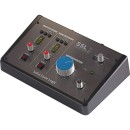
Solid State Logic SSL 2 |
VS | |
|---|---|---|
| Analog: 2 Inputs / 2 Outputs at 192 kHz |
Channels of I/O |
Analog: 2 Inputs / 4 Outputs at 192 kHz |
| 192 kHz / 24-Bit | Maximum Sampling Rate | 192 kHz / 24-Bit |
| 2 Preamps | Number of Microphone Inputs | 2 Preamps |
| 2x Combo XLR-1/4" TRS Balanced/Unbalanced Mic/Line/Hi-Z Input 2x 1/4" TRS Balanced Monitor Output 1x 1/4" TRS Unbalanced Headphone Output |
Analog Audio I/O |
2x Combo XLR-1/4" TRS Balanced/Unbalanced Mic/Line/Hi-Z Input 2x 1/4" TRS Balanced Monitor Output 4x RCA TS Unbalanced Line Output 2x 1/4" TRS Unbalanced Headphone Output |
| 1x USB-C | Host Connection | 1x USB-C |
| macOS 10.11 macOS 10.12 macOS 10.13 macOS 10.14 macOS 10.15 Windows 8.1 Windows 10 |
OS Compatibility |
macOS 10.11 macOS 10.12 macOS 10.13 macOS 10.14 macOS 10.15 Windows 8.1 Windows 10 |
| USB Bus Power | Power Requirements | USB Bus Power |
